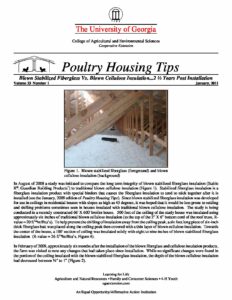In August of 2008 a study was initiated to compare the long term integrity of blown stabilized fiberglass insulation (Stable R®, Guardian Building Products*) to traditional blown cellulose insulation (Figure 1). Stabilized fiberglass insulation is a fiberglass insulation product with special binders that causes the fiberglass insulation to tend to stick together after it is installed (see the January, 2009 edition of Poultry Housing Tips). Since blown stabilized fiberglass insulation was deve...loped for use in ceilings in residential houses with slopes as high as 45 degrees, it was hoped that it would be less prone to settling and shifting problems sometimes seen in houses insulated with traditional blown cellulose insulation. The study is being conducted in a recently constructed 66' X 600' broiler house. 500 feet of the ceiling of the study house was insulated using approximately six inches of traditional blown cellulose insulation (to the top of the 2" X 6" bottom cord of the roof truss, R-value = 20 ft2*hr/Btu’s). To help prevent the shifting of insulation away from the ceiling peak, a six foot long piece of six-inch thick fiberglass batt was placed along the ceiling peak then covered with a thin layer of blown cellulose insulation. Towards the center of the house, a 100' section of ceiling was insulated solely with eight to nine inches of blown stabilized fiberglass insulation (R-value = 26 ft2*hr/Btu’s, Figure 4).
In February of 2009, approximately six months after the installation of the blown fiberglass and cellulose insulation products, the farm was visited to note any changes that had taken place since installation. While no significant changes were found in the portion of the ceiling insulated with the blown stabilized fiberglass insulation, the depth of the blown cellulose insulation had decreased between ½" to 1" (Figure 2).
In February of 2011 the farm was visited once again to document any changes that had taken placed since the ceiling was insulated. Though there were no significant changes in the stabilized fiberglass insulation, the depth of the blown cellulose insulation had decreased between one and two inches since installation (There were some isolated areas of the ceiling, near the eaves, where the reduction in depth was closer to three inches - Figure 5). It is important to note that what appeared to be settling near the eaves may be in part due to the movement of insulation caused by increased air velocities that generally occur in this area of the attic on windy days and the fact that the original insulation depth was slightly less due to difficulties involved in blowing insulation near the eaves of a house. In general, what was originally a ceiling with a R-value of 20 ft2*hr/Btu’s (5 ½" blown cellulose) after two and a half years had decreased to one with a R-value of 15 ft2*hr/Btu’s (4" blown cellulose).....
Details
| Year | Volume | Number | Categories |
|---|---|---|---|
| 2010 | 23 | 1 |

